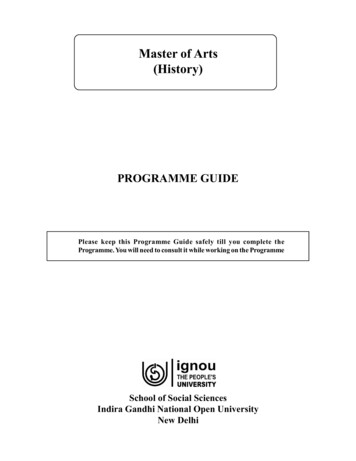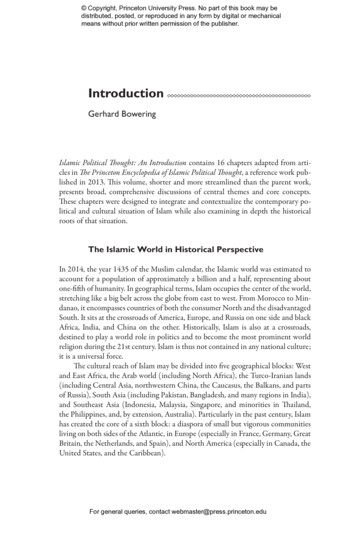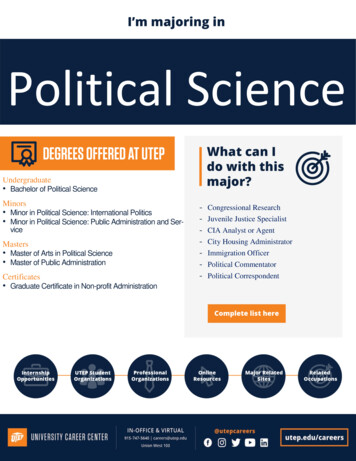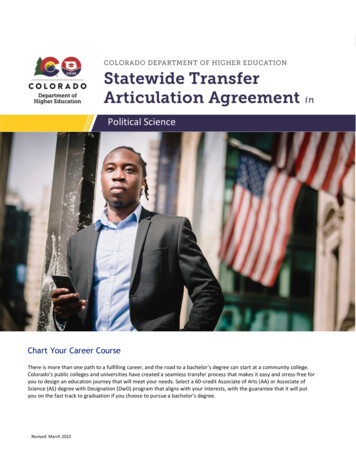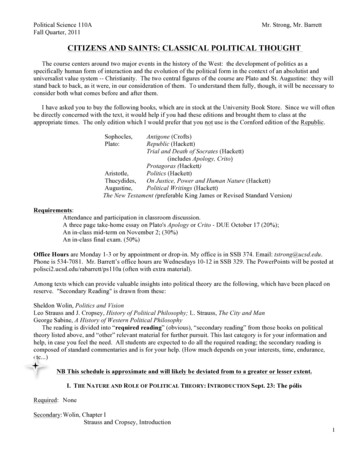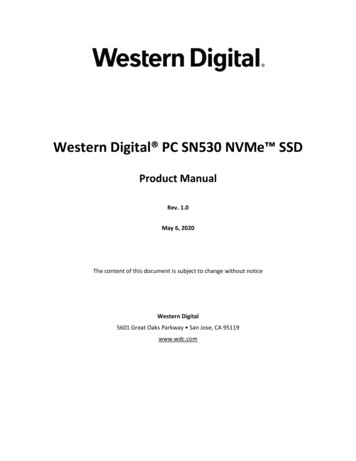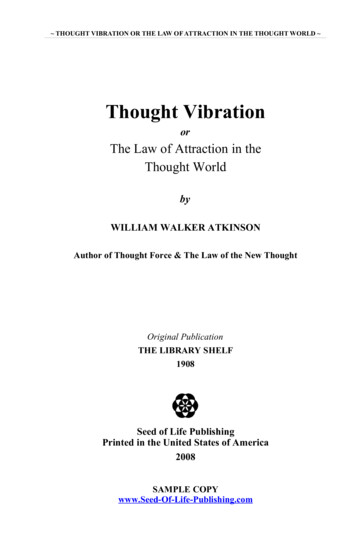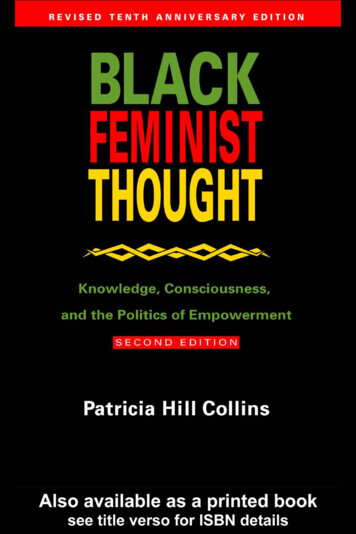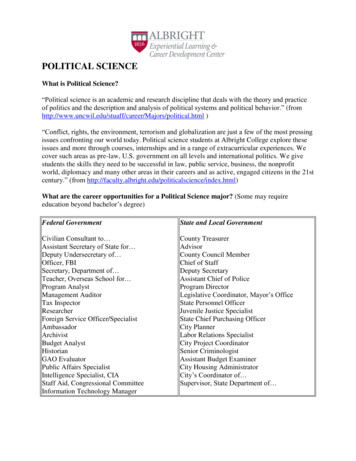
Transcription
Courses offered in the Department of Political ScienceUniversity of HyderabadDepartment of Political ScienceM.A. I- SemesterSyllabus for Course on: Western Political ThoughtM.A.: Compulsory CourseCourse number: PS- 401Credits: 4Course Instructor:Duration: July-DecemberCourse Outline:This course deals with the classical thinkers and themes of western political philosophy. We willprobe the key concerns of political thought such as justice and the good ideal and possible regimes,citizenship and civil virtues, contract, consent and trust as the basis of political obligation and therelative autonomy of politics vis-à-vis philosophy or economy. We will attempt to understandthinkers and texts both from philosophical and historical perspective. The main objective is to trainstudents in the foundational texts and thinkers of political science.1. Plato: Justice in individual and city—cave allegory—philosopher kings—wisdom and itsrelationship to politics.2. Plato, Republic3. Aristotle: Polis and the good life—constitution regimes and citizenship-tensions betweenwealth, virtue and freedom—politics and phronesis or practical wisdom.4. Aristotle, Politics5. Niccold Machiavelli: Strategies and tactics of consolidating power - Gandhi versus thepeople – Autonomy of the political – civic virtues and Republicanism.6. Machiavelli, The Prince and Discourses7. Thomas Hobbes: State and nature and hypothetical contract-grounds of politicalobligation—absolute sovereign—the new science and society.8. Hobbes ,Leviathan9. Johan Locke: Nature law and reason – consent and political authority—limited governmentand property.10. Locke, Second Treatise11. Rousseau: Unspoilt natural condition of humans –material progress, civilization andinjustice—the general will—Great legislator and civil religion.12. Rousseau, The Social Contract13. Mary Wollstonecraft: Natural rights and inequality of women; incorporating women intothe social contract—natural rights and natural duties.14. John Stuart Mill: Utilitarian legacy-individuality, freedom and progress15. John Mill, On Liberty16. Karl Marx: The state and bourgeois rule-capitalism and alienation – worker’sconsciousness and revolution.17. Marx, The Communist Manifesto
Secondary Readings1. Bluhm, W.T. Theories of Political Systems: Classics of Ancient and Modern PoliticalThought, Prentice Hall, New Delhi, 1981.2. Dunning, William. A History of Political Theories, Allahabad, 1966.3. Bernstein, William. Modern Political Thought, Oxford and IBH, 1974.4. Jones, W.T. Masters of Political Thought, OUP, 1975.5. Sabine, G.H. A History of Political Theory. OUP, 1973.6. Strauss, Leo and Cropsey, Joseph. History of Political Philosophy, Chicago, 1987.7. Voegelin, Eric. Order and History: Plato and Aristotle, Louisiana State University Press,1957.8. Wiser, James. Political Philosophy: A History of the Search for Order. Prentice-Hall,1982.9. Wolin, Sheldon, Politics and Vision, University of California Press.
University of HyderabadDepartment of Political ScienceM.A. I- SemesterSyllabus for Course on: Comparative PoliticsM.A.: Compulsory CourseCourse number: PS- 402Credits: 4Course Instructor: Dr. B. Chandra Sekhara RaoDuration: July-DecemberCourse Outline:1.2.3.4.Comparative Politics: As a Method and an Area of Enquiry.Understanding Concepts: State, Nation and Democracy etc.Approaches to Comparative Politics:Elements of Comparisona) Constitution and Institutionsb) Political Culturec) Political Developmentd) Party system and Political participatione) Modernizationf) LegitimacyIdentities4. Comparative Perspectives of Third World Regimesa) Parliamentary Modelb) Military Regimec) Communist System1. Comparative perspective of movementsa) Womens Movementb) Environmentc) Human Rights Movementsd) Ethnic Movements2. Emerging Trends in Comparative Politics.Selected Readings:1. Lucian W.Pye, Aspects of Political Development, Amerind Publications, New Delhi, 1966.2. M.Curtis, Comparative Government & Politics: An Introductory Essay in Political Science,Harper & Row, New York, 1978.3. Jean Blondel, Comparative Government: A Reader, Macmillan Press, London, 1975.4. G.A. Almond and J.S. Coleman, The Politics of the Developing Areas, PrincetonUniversity Press, New Jersey, 19715. G.A. Almond and G.B. Powell, Comparative Politics: A Developmental Approach, Ferrerand Simons, New York.6. Lucian W.Pye and Sidney Verba, Political Culture and Political Development, PrincetonUniversity Press, New Jersey, 1972.7. Shah, Ghanshyam, Social Movements in India: A Review of the Literature, SagePublications, New Delhi, 1990.
8. Malik, S.C. (ed.) Indian Movements: Some Aspects of Dissent, Protest and Reform, IIA,Simla, 1978.9. Oommen, T.K. Protest and Change: Studies in Social Movements, Sage Publications, NewDelhi, 1990.10. Roa, M.S.A., Social Movements and Social Transformation: A Study of Two BackwardClasses Movement in India, Manohar Publications, New Delhi, 1987.11. Roy C. Maeridis, The Study of Comparative Government, Garden City, New York
University of HyderabadDepartment of Political ScienceM.A. I- SemesterSyllabus for Course on: Indian Politics: Institutions and Processes-1M.A.: Compulsory CourseCourse number: PS- 403Credits: 4Course Instructor:Duration: July-DecemberObjective: Teaching politics in a country has to be grounded in understanding and analysis ofpolitics of the country concerned. Thus, this paper seeks to introduce students the key institutionsand processes of governance in India. Organised in seven units, the course deals with historicallegacies and foundations of Indian state and democracy with reference to the making of the IndianConstitution. It examines and locates changing patterns of centre-state relations within the broadframework of transformation of India’s polity from a centralised federation to a multilevel federalsystem. It will engage with the major aspects of the different organs of government, namely thelegislature, executive and the judiciary. It would also examine some of the new institutions thathave emerged in India in recent decades.Mode of evaluation: The paper shall carry a maximum of 100 marks. Students would be requiredto appear in a continuing evaluation of three tests, each of which would carry 20 marks. The besttwo of these three tests would be counted along with the end semester examination, which shallcarry 60 marks.Unit I: Institutional legacies and making of the Constitution:Historical inheritance and institutional legaciesMaking of India’s Constitution: Major features of the ConstitutionFoundational principles/Core values: Fundamental Rights, Directive Principles of State PoliciesUnit II: Institutions of governance:(a) Legislature: Legislation, accountability and representation; Parliamentary Committees;Decline of legislatures?(b) Executive: President: New and emerging role; Prime Minister and Council of Ministers:Collective responsibility and parliamentary accountability; Growing importance of theCabinet; Governor and Chief Ministers: Changing relationship; Civil services(c) The Judiciary: Judicial independence and review; Judicial activism and overreachUnit III: India as a parliamentary federationMajor features of Indian federalism: Tension areas and issues in Centre-State relationsTransformation from centralised federation to multilevel federalismUnit IV: Parties and party systemNational and regional parties: Social and ideological basesTransformation of the party system: From one party dominant system to multiparty systemCoalition governments and coalition politics at the national and state level
Unit V: Regulatory and governance institutions:Planning Commission; Finance Commission; Inter-State CouncilElection Commission of India; National Human Rights CommissionCentral Information Commission, Vigilance Commission; Comptroller and Auditor General; LokPal and LokayuktaReadings: Unit 11. Austin, Granville. 1966. The Indian Constitution: Cornerstone of a nation. Oxford:Clarendon Press, chapter 1, 2, 3 and 4.2. Dasgupta, Jyotirindra. 2001. “India's federal design and multicultural nationalconstruction,” University Press/ Foundation, chapter 3.3. Jha, Shefali. 2008. "Rights versus representation: Defending minority interests in theConstituent Assembly," in Rajeev Bhargava (ed.) Politics and ethics of the IndianConstitution. New Delhi: Oxford University Press, pp.339-353.4. Khosla, Madhav. 2013. The Indian Constitution. New Delhi: OUP short introductionseries.5. Kothari, Rajni.1970. Politics in India. New Delhi: Orient Longman, chapter 2.6. Sarkar, Sumit. 2001. "Indian democracy: The historical inheritance," in Kohli (ed.). Thesuccess of India's democracy, chapter 2.Readings: Unit II1. Hewitt, Vernon and Shirin M. Rai.2010. “Parliament," in Niraja Gopal Jayal and PratapBhanu Mehta (eds). The Oxford companion to politics in India. New Delhi: OxfordUniversity Press, pp.28-42.2. Shankar, B. L., and Valerian Rodrigues. 2010. The Indian Parliament: a democracy atwork. Oxford: Oxford University Press, chapter 1 and 3.3. Austin, Working a democratic Constitution, pp.534-93; pp.604-13.4. Chakrabarty, Bidyut. 2006. "Jawaharlal Nehru and administrative reconstruction in India:A mere limitation of the past or a creative initiative?" South Asia: Journal of South AsianStudies 29 (1), pp.83-99.5. Das, S.K. 2013. The civil services in India. New Delhi: OUP short introduction series6. Khare, H. 2003. "Prime Minister and Parliament: Redefining accountability in the age ofcoalition government," in Ajay K. Mehra, and G.W. Kueck, (eds.). The Indian Parliament:A comparative perspective. New Delhi: Konark, pp.350- 368.7. Krishnan, K.P and T.V. Somanathan. 2005. "Civil service: An institutional perspective,"in Kapur and Mehta, Public institutions in India, chapter 7.8. Manor, James. 2005. "The presidency," in Devesh Kapur and Pratap Bhanu Mehta (eds.).Public institutions in India: Performance and design. New Delhi: Oxford University Press,chapter 3.9. Radin, Beryl. 2007. "The Indian Administrative Service (IAS) in the 21st Century: Livingin an intergovernmental environment". International Journal of Public Administration. 30(12-14), pp.12-14.10. Verma, Arvind. 2005. "The Police in India: Design, performance and adaptability," inKapur and Mehta (eds.), Public institutions in India, chapter 6.11. Rajamani, Lavanya and Arghya Sengupta. 2010. “The Supreme Court” in Jayal and Mehta(eds). The Oxford companion to politics in India, pp.80-97.12. Mehta, Pratap Bhanu. 2007. "The rise of judicial sovereignty," Journal of Democracy 18(2), pp.70-83.13. Sathe, S.P. 2002. Judicial activism in India: Transgressing borders and enforcing limits.New Delhi: Oxford University Press, chapters 2 and 3.
Readings: Unit III1. Arora, Balveer et. al. 2013. “Indian federalism,” in K.C. Suri (ed.) ICSSR research surveysand explorations: Political Science: Indian Democracy, Volume 2. New Delhi: OxfordUniversity Press.2. Arora, Balveer. 1995. "Adapting federalism to India: Multilevel and asymmetrical andinnovations," in Douglas V. Verney and Balveer Arora (eds.). Multiple identities in a singlestate: Indian federalism in comparative perspective. New Delhi: Konark.3. Mathur, Kuldeep. 2013. Panchayati Raj. New Delhi: OUP short introduction series4. Singh, Mahendra P. and Douglas V. Verney. 2003. "Challenges to India's centralisedparliamentary federalism," Publius 33(4),pp.1-20.5. Tummala, Krishna K. 2007. "Developments in Indian federalism: 2005–2007,"AsianJournal of Political Science 15 (2), pp.139-160.Readings: Unit IV1. Kothari, Rajni. 1964. "The Congress 'system' in India," Asian Survey 4(12), pp.1161-73.2. Kothari, Rajni. 1970. "Continuity and change in India's party system," Asian Survey 10(11),pp.937-48.3. Sridharan, 1999. “Coalition politics in India: Lessons from theory, comparison and recenthistory” in D. D. Khanna and Gert W. Kueck (eds.). Principles, power and politics, NewDelhi: Macmillan India.4. Sridharan, E. 2005. "Coalition strategies and the BJP expansion, 1989-2004,"Commonwealth and Comparative Politics 43(2), pp.194-221.5. Sridharan, E. 2010. “Party system," in Jayal and Mehta (eds). The Oxford companion topolitics in India, pp.117-138.6. Suri, K.C. 2005. Parties under pressure: Political parties in India since independence(paper presented for a project on State of democracy in South Asia. Delhi: CSDS).Available online: www.democracy-asia.org/qa/india/KC%20Suri.pdf7. Yadav, Yogendra and Suhas Palshikar. 2006. "Party system and electoral politics in theIndian states, 1952-2002: From hegemony to convergence," in Peter Ronald deSouza, andE. Sridharan (eds.) India’s political parties. New Delhi: Sage, pp.73-115.Readings: Unit V1. Austin, Working a democratic Constitution, pp.614-30.2. Bagchi, Amaresh. 2007. "Role of planning and the Planning Commission in the new Indianeconomy," Economic and Political Weekly, 42(44), pp.92-100.3. Bhagat, Anjana K. 1996. Elections and electoral reforms in India. New Delhi: Vikas,pp.23-102.4. McMillan, Allister. 2010. “The Election Commission” in Jayal and Mehta (eds.), Oxfordcompanion to politics in India, pp. 98-116.5. Rudolph, Lloyd I. and Sussane I. Rudolph. 2001. “Redoing the constitutional design froman interventionist to a regulatory state,” in Kohli (ed.), The success of India’s democracy,pp.127-62.6. Chadda, Maya. 2012. “India in 2011: The state encounters the people,” Asian Survey 52(1),pp.114-29.7. Visvanathan, Shiv. 2012. “Anna Hazare and the battle against corruption,” CulturalCritique 81(spring), pp.103-111.8.
University of HyderabadDepartment of Political ScienceM.A. I SemesterSyllabus for Course on: International Relations IM.A.: Compulsory CourseCourse number: PS 404Credits: 4Course Instructor :Duration: July-DecemberCourse Outline:1. History1.1 Major Landmarks/Developments in International Relations: Post II World1.2. Evolution of International Relations as a Field of StudyWar Era.2. Cold War2.1 United States/Soviet Union Rivalry with Reference to Europe/Asia/Latin America2.2 Deterrence and Détente in International Relations.2.3 De-colonisation and Emergence of Developing Countries2.4 Nonalignment and International Relations2.5 New International Economic Order (NIEO)3. GlobalisationConcepts1.1 National Power, Capability; Understanding Geopolitics1.2 Balance of Power1.3 Security/Collective Security1.4 State System and Non-State Actors; Society of States and System of StatesBibliography:Books:1. Ahuja, Kanta, Huup Coppens and Herman van der Wusten (eds.) Regime Transformation andWorld Realignment, New Delhi, SAGE, 1993.2. Bajpai, Kanti and Shukul Hariss (eds.) Interpreting World Politics, New Delhi, SAGE, 1995.3. Bruce L. Sanders and Durban Alanc, Contemporary International Politics: IntroductoryReadings, New York, John Wiley, 1971.4. Bull, Hedley and Adam Watsom, The Expansion of the Internal Society, Oxford, ClarendonPress, 1984.5. Buzan, Barry, People, States and Fear, Sussex, Wheat Sheaf Books, 1983.6. Calvocoressi, World Politics, New York, Longman, 1982.7. Carr, EH., The Twenty Years Crises 1919-1939, London, Macmillan, 1981.8. Giddens, Anthony, The Third Way, Cambridge, Polity Press, 1998.9. Halliday, Fred, Making of the Second Cold War, London, Verso, 1989.10. Halliday, Fred, Rethinking International Relations, London, Macmillan, 199411. Harshe, Rajen, Twentieth Century Imperialism, New Delhi, SAGE, 1997.12. Malhotra V. Kuman, International Relations, New Delhi, Anmol, 1993.
13. Mayall, James, Nationalism and International Society, Cambridge, Cambridge University Press,1990.14. Mishra,K.P., (ed.) Non-alignment – Frontiers and Dynamics, New Delhi, Vikas, 1982.15. Rahman, M.M., The Politics of Non-alignment, New Delhi, Associated Publishing House,1969.16. Rajan M.S., Non-alignment:India and the Future, Mysore, University of Mysore, 1970.17. Rajan, M.S., and Shivaj Ganguli, (eds.) India and the International System, New Delhi, Vikas,1981.18. Rana, A.P. Imperatives of Non-alignment: A Conceptual Study of India’s Foreign PolicyStrategy in the Nehru Period, Delhi, Macmillan, 1994.19. Rosecrance Richard, Action and Reaction in World Politics, Bostan, Little Brown, 1963.20. Smith, Anthony, State and Nation in the Third World, Sussex, Wheat Sheaf Books, 1983.Journals:AlternativesCurrent HistoryEconomic and Political WeeklyForeign AffairsInternational OrganisationInternational StudiesMillenniumWorld FocusWorld Politics
University of HyderabadDepartment of Political ScienceM.A. II SemesterSyllabus for Course on: Indian Political ThoughtM.A.: Compulsory CourseCourse number: PS- 454Credits:4Course Instructor :Duration: January-AprilThe purpose of this course is to introduce Indian political thought in order for the student tomake sense of current trends in politics in an informed way. It looks at issues and conflictswithin the political realm that have for ever been of interest in making sense of currentpolitics, while noting the breaks and departures through which contemporary Indian politicsis comprehended and negotiated.1. Introduction to Indian Society and Polity: The early beginnings: texts, trends, sources andchallenges.a. Romila Thapar, Early India: From the Origins to AD 1300, Allen Lane, New Delhi,2002 (Chapters 1,4,5,7,12).b. D. D. Kosambi, Living Prehistory in India’, in CombinedMethods in Indology andOther Writings, Oxford UniversityPress, New Delhi, 2002.c. G.C. Pande, Political Order and Ideas’, in Foundations of Indian Culture:Dimensions of Ancient Indian Social History, Volume II, Motilal Banarsidass,Delhi, 2007 imprint.d. Myron Weiner, Ancient Indian Political Theory andContemporary IndianPolitics’, in Orthodoxy, Heterodoxy and Dissent in India, edited by S.N. Eisenstadt,Reuven Kahaneand David Shulman, Mouton Publishers, Berlin, 1984.e. Pollock, Sheldon. “Is there an Indian Intellectual History?Introduction to “Theoryand Method in Indian intellectualhistory.” Journal of Indian Philosophy, Vol. 37(January2009):533-542.f. Ainslie T. Embree (ed.), Sources of Indian Tradition, VolumeOne: From theBeginning to 1800, Penguin Books, New Delhi,1988, (Part I).g. J. N. Mohanty, Indian Philosophy: A historical Overview –origins: Rise of AntiVedic, Naturalistic and SkepticalThinking’, in Classical Indian Philosophy, OxfordUniversityPress, New Delhi, 2000.h. Upinder Singh, Cities, Kings, and Renunciants: NorthIndia, c. 600-300 BCE’, inA History of Ancient and EarlyMedieval India: From the Stone Age to the 12thCentury, Pearson Longman, Delhi, 2008.2. Key concepts and their political salience.a. William Halbfass, Man and Self in Traditional IndianThought’, in Tradition andReflection: Explorations in IndianThought, State University of New York Press,New York,1991.b. Donald R. Davis, Jr., The Spirit of Hindu Law, Cambridge University Press, NewDelhi, 2010 (Introduction and chapters 6 & 7).c. J. Duncan M. Derrett, The Concept of Duty in Ancient Indian Jurisprudence: TheProblem of Ascertainment’ in The Concept of Duty in South Asia, edited by Wendy
Doniger O’ Flaherty and J. Duncan M. Derrett, Vikas Publishing House, NewDelhi, 1978.d. Paul Hacker, Dharma in Hinduism’ in Journal of Indian Philosophy (2006)34:479-496.e. Parasher-Sen, Aloka. “The Self and the other in early Indian Tradition.” In RupaPratirupa: Mind Man and Mask, edited by S.C. Malik, New Delhi: Aryan BooksInternational.3. State and the theories of Kingship: Power, Sovereignty, Justice and Citizenshipa. Jeannine Auboyer, The Political and Administrative Structure’, in Daily Life inAncient India: From 200BC to 700AD, Phoenix Press, London, 1965.b. Brajadulal Chattopadhyaya, Autonomous Spaces’and the Authority of the State:The Contradiction and Its Resolution in Theory and Practice in Early India’, inStudying Early India: Archaelogy, Texts and Historical Issues, Permanent Black,Delhi, 2003.c. Uma Chakravarti, Conceptualizing Brahmanical Patriarchy in Early India: Gender,Caste, Class and State’, in Beyond the Kings and the Brahmanas of Ancient’ India,Tulika Books, New Delhi, 2006.d. J.N. Mohanty, State, Society and Law’, in Classical Indian Philosophy, OxfordUniversity Press, New Delhi, 2000.e. Gen’ichi Yamazaki, State and Kingship in the Period of the SixteenMahajanapadas in Ancient North India’, in The State in India: Past and Present,edited by Masaaki Kimuru & Akio Tanabe, Oxford University Press, New Delhi,2006.f. SteveMuhlberger, gu.ca/muhlberger/HISTDEM/INDIADEM.HTMg. Ananda K. Coomaraswamy, Spiritual Authority and Temporal Power in the IndianTheory of Government, IGNCA & Oxford University Press, Delhi, 1993.h. Richards, John F., ed. Kingship and Authority in South Asia. Delhi: OxfordUniversity Press, 1998.4. The Unorthodox trends: Heterodoxy, heresy and dissent in Jain, Buddhist, and materialistinterventions: An alternative view of politics.a. Andrew J. Nicholson, Affirmers (Astikas) and Deniers (Nastikas) in IndianHistory’, in Unifying Hinduism: Philosophy and Identity in Indian IntellectualHistory, Columbia University Press, New York, 2010.b. Kancha Ilaiah, God as Political Philosopher: Buddha’s Challenge to Brahminism,Samya, Calcutta, 2000 (Chapters 4 &5).c. Uma Chakravarti, The Social Philosophy of Buddhism and the Problem ofInequality’, in Beyond the Kings and the Brahmanas of Ancient’ India, TulikaBooks, New Delhi, 2006.d. Brijadulal Chattopadhyaya, Other, or the Others? Varieties of Difference in IndianSociety at the turn of the first Milennium and Their Historiographical Implications’,in Studying Early India: Archaelogy, Texts and Historical Issues, Permanent Black,Delhi, 2003.e. B.R. Ambedkar, The Buddha and His Dhamma, edited, introduced and annotatedby Aakash Singh Rathore and Ajay Verma, Oxford University Press, New Delhi,2011 (chapters 3 & 4).
f. Gail Omvedt, Understanding Caste: From Buddha to Ambedkar and Beyond,Orient BlackSwan, Hyderabad, 2011 (chapters 1 & 2).g. J. L. Brockington, Unorthodox Movements’, in The Sacred Thread, OxfordUniversity Press, New Delhi, 2000.h. D.P. Chattopadhyaya, Lokayata: A Study in Ancient Indian Materialism, People’sPublishing House, New Delhi, 1959.5. New notions of power, authority, freedom and equality: Muslim Rule and the Emergence ofSikh Kingdoms.a. Yohanan Friedman. “Medieval Muslim Views of Indian Religions.” Journal of theAmerican Oriental Society, Vol. 95, no, 2 (1975): 214-221.b. Richard M. Eaton, Approaches to the Study of Conversion to Islam in India’, inReligious Movements in South Asia 600-1800, edited by David N. Lorenzen,Oxford University Press, New Delhi, 2004.c. Muzaffar Alam, Shari’a, Akhlaq and Governance’, in The Languages of PoliticalIslam in India, c. 1200-1800, Permanent Black, Delhi, 2004.d. Kesavan Veluthat, The Early Medieval in South India, Oxford University Press,New Delhi, 2009 (Chapters 5, 9 & 15).e. J.S. Grewal, The Sikhs of Punjab (The New Cambridge History of India),Cambridge University Press, New Delhi, 1991.f. J.S. Bains, The Political Ideas of Guru Nanak’, The Indian Journal of PoliticalScience, Volume 23, No. 1/4 (January- December, 1962), pp. 309-318.g. Adam Bowles, Governance and Religious Conflict in the Eighteenth Century:Religion and the Discourse of Separateness in the Maratha Polity’, in South Asia:Journal of South Asian Studies, n.s., Vol. XXXIII, no. 1, April 2010.6. Bhakti and the Vernacularisation of Politics: Sectarian developments and the challenges to theorthodox synthesis.a. Tradition and Modernity in Bhakti Movements, edited by Jayant Lele, Brill, 1981(Introduction).b. Jayant Lele, The Political Appropriation of Bhakti: Hegemony and Dominance inMedieval Maharashtra’, in Hindutva: The Emergence of the Right, EarthwormBooks, New Delhi, 1995.c. Anna S. King, Introduction’, in The Intimate Other: Love Divine in IndicReligions, edited by Anna S. King and John Brockington, Orient Longman,Hyderabad, 2005.d. Milind Wakankar, Subalternity and Religion: The prehistory of Dalit empowermentin South Asia, Routledge, New Delhi, 2010 (Parts 1 & III).e. Andrew Schelling, Introduction’, in The Oxford Anthology of Bhakti Literature,Oxford University Press, New Delhi, 2011.7. Indology, Orientalism and the Politics of Colonial representation.a. Said, W. Edward. “Representing the Colonized: Anthropology’s Interlocutors.”Critical Inquiry, Vol. XV, no, 2 (Winter 1989): 205-225.b. Hussain, Asaf. “The Ideology of Orientalism.” In Orientalism, Islam, and Islamists,edited by Asaf Hussain, Robert Olson and Jamil Qureshi, 5-21. Amana Books,1984.
c. Inden, Ronald. “Orientalist Construction of India.” Modern Asian Studies, Vol. XX, no,3 (1986): 401-446.d. Bagchi, Amiya Kumar. “Colonialism and the Nature of Colonial Enterprise inIndia.” Economic and Political Weekly, Vol. XXII, no, 31(July 1988): PE-38-PE49.e. David N. Lorenzen, Who Invented Hinduism?: Essays on religion in History, YodaPress, New Delhi, 2006. See pages 1- 36 for the essay Who Invented Hinduism?’.f. William Gould, The Aryan Congress: history, youth and the Hindu race’’, inHindu Nationalism and the Language of Politics in Late Colonial India, CambridgeUniversity Press, Delhi, 2005.g. Vasudha Dalmia, Orienting India: European knowledge formation in theEighteenth and Nineteenth centuries, Three Essay Collective, New Delhi, 2003.8. Nationalisms and nationalist ideology: Contemporary challenges to these concepts and trends.a. Mantena, Karuna. “On Gandhi’s Critique of the State: Sources, Contexts, andConjunctures.” Modern Intellectual History, Vol. IX, no, 3 (2012): 535.563.b. Bacchetta, Paola. Gender in the Hindu Nation. Women Unlimited,2004.c. Aishwary Kumar. Ambedkar’s Inheritances’ in Modern Intellectual History, 7, 2(2010).d. Aishwary Kumar, The Ellipsis of Touch’, Public Culture, 23:2, 2011.e. Sarkar, Tanika. “Rabindranath’s Gora and the Intractable Problem of IndianPatriotism.” Economic and Political Weekly, Vol. XLIV, no. 30 (July 2009): 3745.f. Faisal Devji, Apologetic Modernity’, in An Intellectual History for India, Editedby Shruti Kapila, Cambridge University Press, Delhi, 2010.g. Perry Anderson, The Indian Ideology, Three Essays Collective, Gurgaon, 2012.
University of HyderabadDepartment of Political ScienceM.A. II SemesterSyllabus for Course on: Indian Politics: Major issues and DebatesM.A.: Compulsory CourseCourse number: PS- 455Credits: 4Course Instructor:Duration January-AprilObjectives: This paper introduces students to key issues and debates that occupied a central placein Indian politics over the past six decades since India became an independent democratic republic.Organised into six units, the course begins by examining the major perspectives that shaped andinformed the Indian Politics over the years. It then examines the politics of major social identitiesin Indian politics, viz, caste, class, tribe and gender. How language, region, and ethnicity not onlyunderpin the reorganisation of India’s federal polity but also how they define the contentiousdiscourse on regionalism and secessionism would be discussed. Issues such as communalism andsecularism, civil society and the state; and the politics of economic reforms would be other majorthemes in the course.Mode of evaluation: The paper shall carry a maximum of 100 marks. Students would be requiredto appear in a continuing evaluation of three tests, each of which would carry 20 marks. The besttwo of these three tests would be counted along with the end semester examination, which shallcarry 60 marks.Course outlineUnit I: Major perspectives on Indian politicsLiberal, Marxist, Subaltern and Feminist: Western and IndianUnitII:ThepoliticsofidentitiesinCaste, tribe, class and gender: Domination, recognition, mobilisation and social justiceIndiaUnit III: Regionalism and secessionisma. Language, region, and ethnicity: Demand for separate states; salience of regional parties atthe national and state levelb. Autonomy and Secessionism: Accommodation or Integration?Unit IV: Communalism and secularisma. The role of religion in politics; Minoritiesb. Debates on nationalism, communalism, and secularismUnit V: Civil society and the statea. Social Movements; Non-governmental organisationsb. Development and displacementc. Anti-Corruption movementsd. Political reformsUnit VI: Policy and politics in the era of economic reformsa. The policy and politics of economic reformsb. Agrarian crisis; growing disparities and inclusive growthc. Business and politics
Unit VII: Assessing Indian state and democracyReadings: Unit Ia. Chatterjee, Partha. 2010. "The state," in Niraja Gopal Jayal and Pratap Bhanu Mehta (eds).The Oxford companion to politics in India. New Delhi: OUP, pp.3-14.b. Das, Samir Kumar. 2013. “Introduction: Surveying the literature on state in postIndependence India,” in Samir Kumar Das (ed.). ICSSR research surveys and explorations:Political Science, Vol.1. New Delhi: ICSSR/Oxford University Press.c. Gupta, Sobhan Lal Datta. 2013. “Social Character of the Indian state: A survey of currenttrends,” in Samir Kumar Das (ed.) ICSSR research surveys and explorations: PoliticalScience, Vol.1. New Delhi: ICSSR/Oxford University Press.d. Menon, Nivedita and Aditya Nigam. 2007. Power and contestation: India since 1989. NewDelhi: Zed.e. Mitra, Subrata. 2008. “When area meets theory: Dominance, dissent, and democracy inIndia,” International Political Science Review 29(5), pp.557–78.Readings: Unit IIa. Basu, Amrita. 2010. “Gender and Politics,” in Jayal and Mehta (eds). The Oxfordcompanion to politics in India, pp.168-80.a.b. Deshpande, Ashwini. 2013. Affirmative action in India. New Delhi: OUP shortintroduction series.b.c. Fernandes, Leela and Patrick Heller. 2006. “Hegemonic aspirations: New middle classpolitics and India's democracy in comparative perspective,” Critical Asian Studies, 38(4),pp.495-522.c.d. Guha, Ramchandra. 1996. "Savaging the civilized: Verrier Elwin and the tribal question inlate colonial India," Economic and Political Weekly 31(35/37), pp.2375-80 2383 238589.d.e. Guru, Gopal “Social justice,
Plato, Republic 3. Aristotle: Polis and the good life—constitution regimes and citizenship-tensions between wealth, virtue and freedom—politics and phronesis or practical wisdom. 4. Aristotle, Politics 5.
